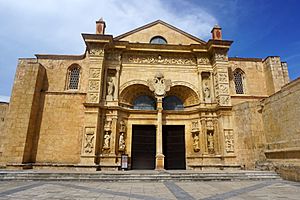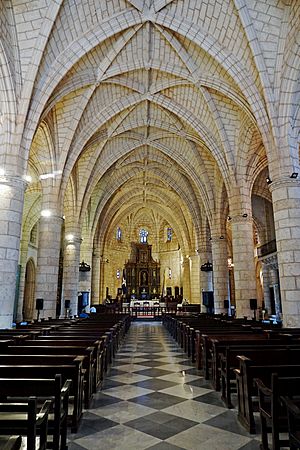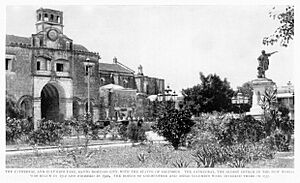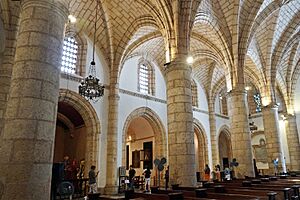Cathedral of Santo Domingo facts for kids
Quick facts for kids Cathedral Basilica of Santa María la Menor |
|
|---|---|

Front entrance to the Cathedral of Santa María la Menor
|
|
| Religion | |
| Affiliation | Catholic |
| Province | Archdiocese of Santo Domingo |
| Location | |
| Location | Santo Domingo, Dominican Republic |
| Architecture | |
| Architectural style | Gothic |
| Groundbreaking | 1504 |
| Completed | 1550 |
| UNESCO World Heritage Site | |
| Part of | Colonial City of Santo Domingo |
| Criteria | Cultural: (ii), (iv), (vi) |
| Inscription | 1990 (14th Session) |
The Cathedral of Santa María la Menor is a very old and important church in Santo Domingo, Dominican Republic. It's special because it was the first cathedral ever built in the Americas. Construction started in 1504 and finished in 1550. It's also known as the "Primate of the Indies" because it was the first main church in the "New World."
The cathedral has a beautiful front made of golden-colored stone. Its style is called Gothic, which means it has tall arches and detailed designs. This makes it a great example of Gothic style outside of Europe. Inside, you can find amazing old art, like wood carvings, furniture, and shiny silver and jewelry.
You can find this historic building right next to Columbus Park in Santo Domingo.
Contents
History of the First Cathedral
The Cathedral of Santo Domingo is the oldest church of its kind in the Americas. Its construction was ordered by Pope Julius II in 1504. Building began in 1512, under the guidance of the first bishop of Santo Domingo, Friar García Padilla. The first plans for the church were made by architect Alonso de Rodríguez.
Work on the cathedral stopped for a while. It then continued in 1522 with new designs by Luis de Moya and Rodrigo de Liendo. Bishop Alessandro Geraldini also helped with the project.
The architect Alonso González, who was inspired by the famous Seville Cathedral in Spain, helped finish part of the church in 1550.
Later, Alonso de Fuenmayor helped move the construction forward. The cathedral was officially made sacred on August 31, 1541.
In 1546, Pope Paul III gave the cathedral an even higher title. He declared it a "Metropolitan Cathedral and Primate of America." This happened because King Charles V, Holy Roman Emperor asked for it.
Another special honor came in 1920. Pope Benedict XV named it a "Minor Basilica of the Virgin of the Annunciation."
In the late 1500s, a Cloister (a covered walkway, usually in a monastery or church) was added on the south side. This area included rooms for the canons, who were priests connected to the cathedral.
In 1547, work on the bell tower was stopped. It was becoming too tall, even taller than the nearby Homage Tower. This caused problems for the guards who watched over the city.
In 1586, the cathedral was taken over by the troops of Sir Francis Drake. They looted the building during their invasion. It seems the cathedral was made sacred again in 1665.
At first, the cathedral had no small prayer rooms called chapels. By 1740, it had 9 chapels, and today it has 14. Some important chapels include those of Alonso de Suazo and Diego Caballero. There is also a special crypt for archbishops and a baptismal chapel.
Among the many treasures inside is a painting called "Our Lady of la Antigua." This painting was given to the cathedral by Christopher Columbus. The large organ inside the church was brought from Magdeburg in 1860.
What the Cathedral Looks Like

The Cathedral of Santo Domingo has a Gothic design. This style is known for its strong walls and ribbed vaults, which are arched ceilings with decorative ribs. The cathedral has three doors. Two are in the Gothic style, and the main one mixes Gothic with a Spanish style called Plateresque.
Inside, the cathedral holds many artistic treasures. These include altarpieces (decorated screens behind altars), paintings, and old wooden furniture. There are also monuments and tombstones. One special painting is of the Virgin of la Altagracia, from 1523.
You can also see the tombs of archbishops from the colonial period. There is even a tombstone for Simón Bolívar, who was an ancestor of the famous South American liberator.
The remains of Christopher Columbus were kept in this cathedral for some time. In 1795, they were moved to the Cathedral of Havana. Finally, between 1898 and 1899, they were moved to the Cathedral of Seville in Spain.
The valuable archiepiscopal throne, also in the Plateresque style, dates back to 1540. It used to be part of the lower choir area. This part was later removed to make space for a marble monument that held Columbus's remains.
The cathedral is built mostly with limestone. Some walls are made of masonry and bricks. It has twelve side chapels, three main sections called naves, and a central nave. The roof of the central nave is pointed. The roofs of the side naves are made of ribbed vaults.
The longest part of the church is 54 meters, from the central nave to the back of the presbytery (the area around the altar). The width of the three naves together is 23 meters. The highest point inside, from the floor to the ceiling, is 16 meters. The total built area is more than 3,000 square meters. Over its history, fourteen side chapels have been added.
Around the cathedral, there are three separate open areas. To the north is the Plaza de Armas, a large square. The main entrance to the church complex has a special front area that looks like a castle wall. To the south is a smaller square called Plazoleta de los Curas. There are also passages around a courtyard, like the Callejón de Curas.
Important People Buried Here
Several important figures in Dominican history are buried in the cathedral:
- Buenaventura Báez – He was president of the Dominican Republic five times.
- Ramón Báez – He was a doctor and also served as president of the Dominican Republic.
- Fernando Arturo de Meriño – He was an archbishop and president of the Dominican Republic.
- Juan Isidro Jimenes Pereyra – He served as president of the Dominican Republic.
Gallery
Exterior
Interior
See also
 In Spanish: Catedral primada de América para niños
In Spanish: Catedral primada de América para niños
- List of colonial buildings in Santo Domingo
- Colonial City of Santo Domingo
- Our Lady of Altagracia
- List of oldest buildings in the Americas
- Gothic architecture#Gothic in the Colonial Americas
- History of the Dominican Republic
- List of basilicas in North and Central America and the Caribbean

























